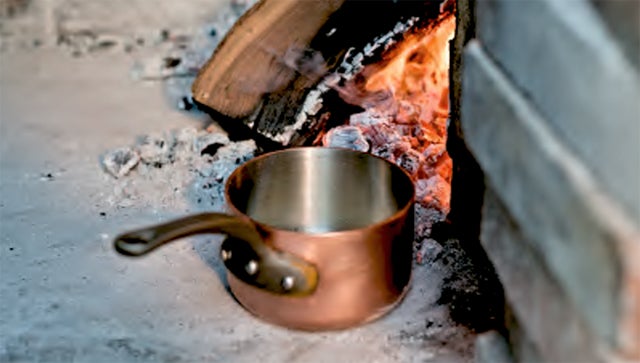Interviewer: “If your house were burning down and you could take one thing, what would it be?”
Jean Cocteau: “The fire.”
“'Fire cooking' is actually a misnomer. You're cooking over the embers,” said Joshua Skenes, chef-owner of Saison in San Francisco and one of Food and Wine's Best New Chefs of 2011.
Sometimes, you don't even need the embers, as he demonstrated:
1. Use a broom to compress the mbers in the corner, clearing just enough space for a small pot.
2. Use the cleared space, the hot bricks, as a “stovetop” for cooking.
This Book Will Change Your Life
Expert advice on happiness, meaning, and secrets to successJosh has become famous for his use of fire. He has classical training and loves his high-end Japanese Nenohi knives, but nothing captures his imagination quite like the open flame. The back of his business card sports three words, stark on ivory white:
Play with fire.
“One of the first things that I cooked in a fire was a leek,” Joshua recounts. “I gently turned it in the ash, and it got carmelized on the outside. I sliced it and put it on a plate with amazing olive oil, local sea salt from Monterey, and Meyer lemon juice. (Meyer lemons have an intoxicating aroma and sweet taste, almost like a blend of lemon and orange.) I ate it and thought, This is out of control. The way fire pulls depth of flavor out is magical.”
Joshua, who's tried everything from fruit woods to fig woods, now uses almond wood from a farm in Northern California as his fuel of choice. He starts his fires with an Iwatani Torch Burner, and the flames are tended all day in the large brick oven outside of the Saison dining room. Much like the Olympic torch, it almost never goes out.
The Iwatani works beautifully, but let's look at how they do things in the world capital of grilling.
THE GAUCHO METHOD
I don't have a long history of wielding fire, but I am a seasoned consumer of parrallada, as grilled meat is known in Argentina. I've witness many all-day Sunday feasts—asados—in the provinces outside of Buenos Aires. These asados are a cultural mainstay and serious business. Roasting a whole lamb, as common in Patagonia as a stuffed turkey in the U.S., often starts at 6 a.m. and finishes near 2 p.m. Argies assume 4lbs (2kg) of meat will be eaten per person at such affairs. Bring your Pepto-Bismol.
Francis Mallmann is the Argentine figurehead of grilling, the capo, the Mickey Mantle of meat.
Raised in the Andes as the son of a preeminent nuclear physicist, Mallmann trained at the most famous French kitchens in the world, later becoming South America's most venerated Patagonian cook. But, in his own words, he was “tired of making fancy French food for wealthy customers in Buenos Aires” and so returned to his mother tongue: fire.
Patagonia is, as he describes it, still much like the Wild West was 100 years ago. Andean gauchos (cowboys) and the Indians before them used methods that he still recommends. For wood, he prefers, in descending order:
1. Oak
2. Maple
3. Birch or hickory
If you have to use charcoal instead of wood, use half the volume. For a serious, large-mammal meal, a minimum of 5lb (2.5kg) of charcoal is needed.
All this in mind, Francis does the following:
LIGHTING A FIRE NEAR CIVILIZATION
00: Start with a crunched-up piece of newspaper or by making a small pile of wood chips.
01: Place a handful of small twigs over your newspaper or wood chips to create a cone.
02: Create a second layer around your cone using slightly larger wood pieces, such as kindling.
03: Gently place a few rolled sheets of newspaper through the gaps at the bottom of your cone; five should be sufficient.
04: Arrange a final layer around your cone using quartered logs no larger than 6″ (15cm) thick and 1 1/2ft (0.5m) long.
05: Ignite the rolls of newspaper and let your fire steadily build until the quartered logs are burning efficiently.
06: Once your fire is burning well, add larger sections of logs or even whole logs up to 1 1/2ft (0.5m) long and 10″ (25cm) in diameter.
To gauge the heat, hold your hand just above where the food will be placed. How long can you keep it there? To confuse people, you can count as they might in Argentina: “uno matador, dos matador, tres matador, quatro matador” and so on, just as Yanks say “one Mississippi, two Mississippi….”
A GENERAL GUIDE
Two seconds: High heat
Three-four seconds: Medium-high heat
Five-six seconds: Medium heat
Seven-eight seconds: Low heat
Seem complicated? Use Steve Rinella's rule of thumb: once you can hold your hand there for roughly three seconds, but no more, you're ready to start cooking.
Excerpted from (New Harvest). Copyright © 2012 by Timothy Ferriss. Used by permission of the author. All rights reserved.


